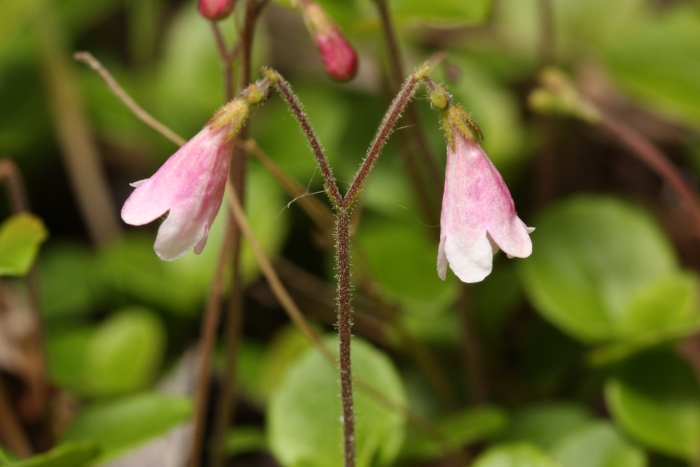Twinflower
(Linnaea borealis)
Twinflower (Linnaea borealis)
/
/

Walter Siegmund (talk)
CC BY-SA 3.0



























































Estimated Native Range
Summary
Twinflower is valued for its delicate appearance, with flowers that are subtly fragrant and attractively displayed above the foliage. It is often used in rock gardens, as ground cover, and in woodland gardens for its evergreen presence and low maintenance requirements. Preferring cool, moist conditions, it thrives in part shade to full shade, and requires well-drained, humus-rich soils. While it tolerates a range of soil moisture levels, it does not do well in dry conditions. Twinflower can be propagated by division or from cuttings, though it is not commonly found in nurseries. It is generally free from serious pests and diseases but can suffer from root rot in poorly drained soils.CC BY-SA 4.0
Plant Description
- Plant Type: Herb, Subshrub
- Height: 0.3-0.5 feet
- Width: 2-3 feet
- Growth Rate: Moderate
- Flower Color: Pink
- Flowering Season: Summer
- Leaf Retention: Evergreen
Growth Requirements
- Sun: Full Sun, Part Shade
- Water: Medium
- Drainage: Slow, Medium, Fast
Common Uses
Bank Stabilization, Bee Garden, Butterfly Garden, Edible*Disclaimer: Easyscape's listed plant edibility is for informational use. Always verify the safety and proper identification of any plant before consumption., Fragrant, Low Maintenance, Rock Garden, Showy Flowers, Water Garden
Natural Habitat
Circumboreal regions, including coniferous and mixed woodlands in North America, boreal forests across Europe, and cool temperate regions of Asia
Other Names
Common Names: American Twinflower, Twin Flower, Northern Twinflower, Pink Bells, Linnæa, Moosglöckchen, Linnée Boréale, Linnaeusklokje, Linnea, 린네풀
Scientific Names: , Linnaea borealis, Linnaea borealis subsp. longiflora, Linnaea borealis var. longiflora, Linnaea borealis var. americana, Linnaea borealis subsp. americana, Linnaea borealis var. borealis, Linnaea americana, Linnaea borealis f. arctica, Linnaea longiflora
GBIF Accepted Name: Linnaea borealis L.